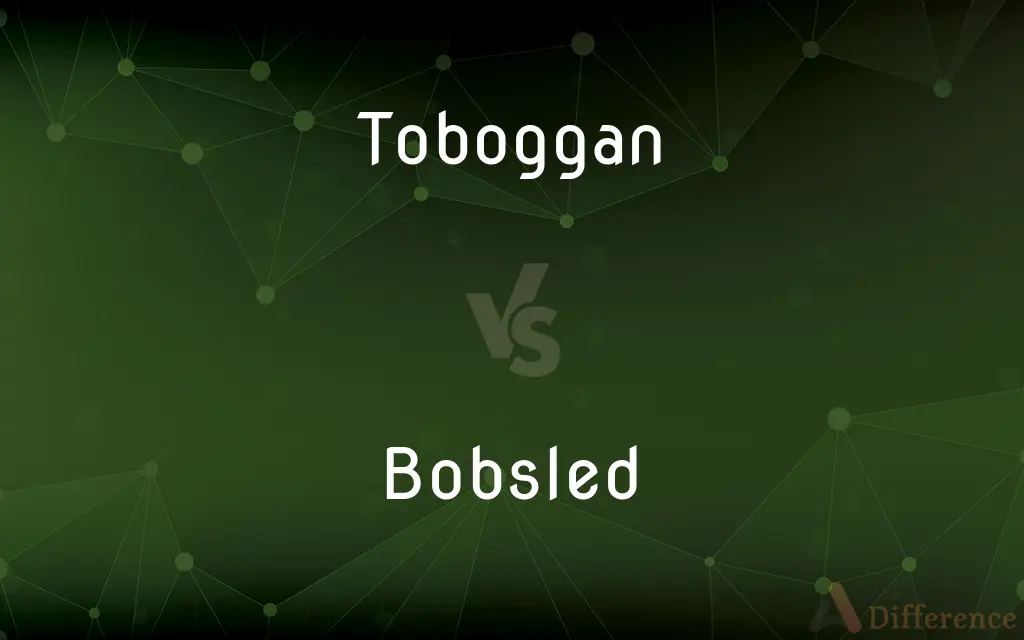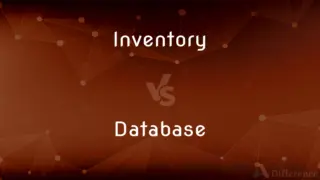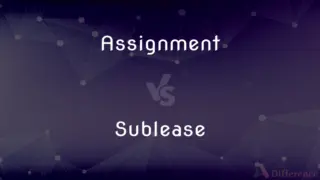Toboggan vs. Bobsled — What's the Difference?
By Tayyaba Rehman & Maham Liaqat — Updated on April 8, 2024
A toboggan is a simple sled without runners, traditionally used for sliding down hills, while a bobsled is a more complex, runner-equipped sled used for racing down ice tracks.

Difference Between Toboggan and Bobsled
Table of Contents
ADVERTISEMENT
Key Differences
Toboggans are characterized by their flat bottoms and curved fronts, designed to glide over snow. They are traditionally made from a single piece of wood or a series of wooden slats bound together. Whereas, bobsleds are engineered for speed and precision on ice tracks, featuring metal runners and a sophisticated steering mechanism to navigate sharp turns at high speeds.
While toboggans are primarily used for leisure and can accommodate multiple riders sitting one behind the other, bobsleds are built for competitive sport, with teams of two or four athletes lying in a prone position to minimize air resistance. This distinction highlights the recreational versus competitive nature of each sled.
The design and construction of toboggans prioritize simplicity and durability, making them accessible for casual winter recreation. On the other hand, bobsleds are the result of advanced engineering, incorporating aerodynamics and materials science to achieve optimal performance, which reflects in their significantly higher cost and maintenance requirements.
Tobogganing is a tradition in many cultures, associated with family and communal enjoyment during the winter months. Bobsledding, however, is recognized as an Olympic sport, requiring specialized tracks, professional training, and adherence to strict international standards, emphasizing the sport's elite status.
Safety considerations also differ markedly between the two. Tobogganing involves relatively low speeds and simple controls, making it suitable for all ages with minimal risk. Bobsledding, by contrast, entails high speeds and a risk of serious injury, necessitating helmets, specialized suits, and safety training for participants.
ADVERTISEMENT
Comparison Chart
Design
Flat bottom with a curved front, no runners.
Aerodynamic design with metal runners and a steering mechanism.
Usage
Leisure activity on snow.
Competitive racing on ice tracks.
Construction Material
Traditionally wood.
High-tech materials including fiberglass and steel.
Rider Position
Sitting upright, multiple riders.
Prone, teams of two or four.
Accessibility
Widely available, used without special training.
Requires access to specialized tracks and training.
Safety
Lower speeds, minimal safety gear required.
High speeds, requires helmets and safety gear.
Cultural Significance
Associated with family fun and tradition.
Recognized as an Olympic sport with professional athletes.
Compare with Definitions
Toboggan
Characterized by its simplicity and lack of steering or braking mechanisms.
Steering the toboggan required skillful shifting of weight by the riders.
Bobsled
Requires specialized tracks for racing, with steep turns and high banks.
The bobsled track was a marvel of engineering, with its intricate curves and steep descents.
Toboggan
Associated with casual winter recreation and outdoor fun.
Their favorite winter activity was tobogganing at the local hill after a fresh snowfall.
Bobsled
Features advanced design for aerodynamics and speed, with athletes lying prone.
The aerodynamic design of the bobsled minimized air resistance, increasing their speed.
Toboggan
Suitable for group rides with riders sitting in a line, one behind the other.
The kids piled onto the toboggan, laughing as they slid down the slope together.
Bobsled
A high-speed sled equipped with metal runners and a steering mechanism for ice tracks.
The bobsled team practiced daily, perfecting their turns on the ice track.
Toboggan
A simple, flat-bottomed sled without runners, used for sliding down snow-covered hills.
They spent the afternoon tobogganing down the hill in the park.
Bobsled
Used in competitive sports, including Olympic races, requiring teams of two or four.
They won the gold medal in four-man bobsled at the Winter Olympics.
Toboggan
Traditionally made from wood, designed for recreational use by people of all ages.
The handmade wooden toboggan was a family heirloom passed down through generations.
Bobsled
Associated with professional athletes and rigorous training regimens.
Bobsledding required not just physical strength, but also precision teamwork and strategy.
Toboggan
A toboggan is a simple sled traditionally used by children. It is also a traditional form of transport used by the Innu and Cree of northern Canada.
Bobsled
A long metal racing sled with a steering mechanism that controls the front runners and a hand brake, usually raced down a curving ice-covered course by crews of two or four riders.
Toboggan
A long, narrow, runnerless sled constructed of thin boards curled upward at the front end.
Bobsled
A long sled made of two shorter sleds joined in tandem.
Toboggan
To coast, ride, or travel on a toboggan.
Bobsled
Either of these two smaller sleds.
Toboggan
(Slang) To decline or fall rapidly
His good fortune has tobogganed.
Bobsled
To ride or race in a bobsled.
Toboggan
A long sled without runners, with the front end curled upwards, which may be pulled across snow by a cord or used to coast down hills.
Bobsled
A sled used to go down a bob track.
Toboggan
A similar sled of wood, pulled by dogs, possibly with steel runners, made to transport cargo.
Bobsled
The sport of travelling down a bob track as fast as possible.
Toboggan
(figurative) Something which, once it starts going (figuratively) downhill, is unstoppable until it reaches the bottom.
Bobsled
A short sled, mostly used as one of a pair connected by a reach or coupling; the compound sled so formed.
Toboggan
A knit cap, designed to provide warmth in cold weather.
Bobsled
To ride a bobsled.
Toboggan
To slide down a hill on a toboggan or other object.
Bobsled
A short sled, mostly used as one of a pair connected by a reach or coupling; also, the compound sled so formed.
The long wagon body set on bobsleds.
Toboggan
(figurative) To go downhill unstoppably until one reaches the bottom.
Bobsled
A long racing sled (for 2 or more people), having two pairs of runners, with the front pair connected to a steering mechanism. They are usually raced one at a time down a steeply sloping path or specially constructed chute, with sharp banked curves, and attain high speeds.
Toboggan
To fly sharply downward so as to build up speed to facilitate in-flight refueling of a faster aircraft.
Bobsled
Formerly two short sleds coupled together
Toboggan
A kind of sledge made of pliable board, turned up at one or both ends, used for coasting down hills or prepared inclined planes; also, a sleigh or sledge, to be drawn by dogs, or by hand, over soft and deep snow.
Bobsled
A long racing sled (for 2 or more people) with a steering mechanism
Toboggan
To slide down hill over the snow or ice on a toboggan.
Bobsled
Ride a bobsled;
The boys bobbed down the hill screaming with pleasure
Toboggan
A long narrow sled without runners; boards curve upward in front
Toboggan
Move along on a luge or toboggan
Common Curiosities
Can toboggans be used on bobsled tracks?
Toboggans are not designed for the icy, steep, and curved tracks used in bobsledding and lack the necessary safety features for such environments.
How do you steer a toboggan?
Steering a toboggan usually involves shifting the riders' weight or dragging feet or hands on the side of the sled to turn.
What is the main difference between a toboggan and a bobsled?
The main difference lies in their use and design: toboggans are simple, flat-bottomed sleds for leisure, while bobsleds are complex, runner-equipped sleds for competitive racing.
What makes bobsleds faster than toboggans?
Bobsleds have aerodynamic designs, metal runners, and a steering mechanism that allow for greater speed and precision on ice tracks.
Is tobogganing safe for children?
Yes, tobogganing is generally safe for children, provided they are supervised and wear basic safety gear like helmets.
Are bobsleds only used in the Olympics?
While bobsledding is an Olympic sport, there are also world championships and other competitions outside the Olympics.
Can multiple people ride a toboggan at the same time?
Yes, toboggans are designed to accommodate multiple riders sitting one behind the other.
Are there different types of toboggans?
Yes, there are variations in materials and sizes, but the basic design principle remains the same.
How expensive is a bobsled?
A competitive bobsled can cost tens of thousands of dollars, not including maintenance and the cost of using professional tracks.
Do you need special training to ride a bobsled?
Yes, bobsledding requires special training to handle the sled's speed, steering, and the track's demands safely.
What type of competitions are available for bobsledding?
Competitions include the Olympic Games, World Cup races, and world championships, among others.
What safety equipment is required for bobsledding?
Bobsledders wear helmets, bodysuits, and sometimes other protective gear to prevent injuries during high-speed races.
How long have toboggans and bobsleds been used?
Both have historical roots extending back centuries, but bobsledding as a sport developed in the late 19th century.
Share Your Discovery

Previous Comparison
Inventory vs. Database
Next Comparison
Cockerel vs. CaponAuthor Spotlight
Written by
Tayyaba RehmanTayyaba Rehman is a distinguished writer, currently serving as a primary contributor to askdifference.com. As a researcher in semantics and etymology, Tayyaba's passion for the complexity of languages and their distinctions has found a perfect home on the platform. Tayyaba delves into the intricacies of language, distinguishing between commonly confused words and phrases, thereby providing clarity for readers worldwide.
Co-written by
Maham Liaqat














































